Guest Story: Anette & Jürgen
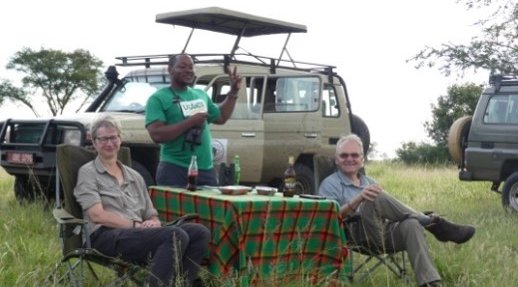
"But the highlight of the day - or even of the whole trip - is a serval, which we see in the evening! It is already dusk but it's on the move right next to the path."
Written by Anette (translated from German), December 2021 (referring to a guided safari in October 2021)
After the restrictions imposed by Corona, we were hesitant to plan a trip to Africa. However, as I was planning a three-week voluntary service in Uganda, at the chimpanzee sanctuary on Ngamba Island on Lake Victoria, we then booked a three-week round trip through the "green" Africa. - So far we had only visited Namibia and spent a few days in Botswana and Zimbabwe.
Fortunately, my husband was able to join us for the subsequent round trip without any problems. We meet at night at the quietly situated Secrets Guest House in Entebbe.
Early the next morning, our guide and driver Balam picks us up there and we set off north, towards Jinja on the Nile.
We are amazed at the dense population, comparable to the population in Germany, the amount of agriculture and the fact that everyone seems to be on the move. The people are very friendly and at the roadside the children enthusiastically call "Mzungu" (white man), "Hello" and "Bye bye" and wave. After my husband had had a short night, we decide to spend the afternoon lazily at the beautifully situated Nile Porch Resort. Swimming in the pool, watching monkeys and birds in the park-like garden, that's action enough for today. We only manage to get up for an evening bird-watching trip. It is really interesting and Jimmy, the boat driver, knows his stuff. Apart from the impressive Nile, there is a Nile monitor in a tree, but of course the local population also uses the river for fishing, bathing, washing, ...
The dinner at the resort is excellent and plentiful. The spare rips are highly recommended!
The drive the next morning continues north through partly watery terrain to the Sipi Falls. From the beautifully situated Rafiki Lodge Sipi, one has a magnificent view of the waterfalls and can look far out over the country. From the lodge, we set off on a hike to the various Sipi waterfalls. There are three waterfalls in total, each impressive. Behind the first waterfall you can even walk and look out through the veil of water. It is wet and muddy, but the landscape is beautiful and our guide for the hike tells us a lot of interesting things about the country and its people along the way. We learn the greeting in the language spoken in the area and earn friendly smiles from the people. The path leads steadily more or less uphill until we reach the second waterfall. The spray soaks us again. Finally, we drive close to the waterfall, which can also be seen from the lodge. It is the highest of the waterfalls and our hiking guide shows us how to take really "magical" photos there. But they remain a secret... After visiting the waterfalls, we drive to a small bat cave. We have to crawl in on all fours, but there is much more space inside. In the back of the cave there are beautiful crystals on the ceiling.
The rooms of the lodge are beautiful and the food here is also delicious. It's a pity we aren't staying longer!
We make another stopover in Morot, at the Kara-Tunga Guesthouse. As it is still early in the afternoon, we take a walk through the village. We are probably the only white people on the street and stand out accordingly. But we don't feel unsafe at all, the people are very friendly.
The landscape becomes even drier on the way to Kidepo Valley National Park, further north. It borders to South Sudan. On the way there are a lot of birds, whose names Balam knows. So we stop again and again. Today's destination is the Kidepo Savannah Lodge, right on the edge of the national park. On the way, Balam even discovers a chameleon on the side of the road, which he carefully captures for us. No animal escapes his gaze!
On the way to the lodge, we make a first detour into the national park. We see many hartebeests, Uganda kobs and waterbucks. We even spot a lioness in the shade of a tree shortly after entering the park! We move into our safari tent at Kidepo Savannah Lodge. From there you can see all the way into the national park. The next morning, we go on another game drive into the national park. We see many antelopes, but also giraffes, waterbucks, warthogs, ... Even a few of the shy eland antelopes are there! Unfortunately, we cannot visit the northern part of the park, as it has already rained too much. But Balam does his best to track down lions for us. It is like a jinx, in all the places where he suspects they are, they are not there.
But just before lunch, when we are resting a little after the morning game drive, Balam comes running and says he wants to show us a surprise.
He leads us to the car and off we go into the park. At one of the rock groups where we had regularly stopped by, two male lions are lying in the shade!
The next morning, we visit the Karamajong, a semi-nomadic pastoralist people. We learn a lot about their about their life and are shown songs and dances. Of course, we are also supposed to shop for handicrafts in the village square, which we gladly do. It has been a highly interesting visit!
Our next destination is the Murchison Falls National Park. We stay at Pakuba Safari Lodge, where waterbucks graze in front of the houses in the evening. Supposedly you can also come across hippos, but we don't encounter any - which is what we prefer...
The park is much greener than Kidepo National Park. There are a lot of animals here too: elephants, red-shielded giraffes, buffaloes, various antelopes and, of course, crocodiles and hippos near the Nile. Our personal highlight are definitely two young leopards chasing each other through a treetop. Balam has spotted them, leopards are his favourite animals. We are quickly joined by other tourist vehicles. The leopards are far away, but it is an incomparable spectacle! The whole treetop shakes with the wild game of tag! Of course, a visit to the impressive Murchison Falls is also on the agenda. First, we take the excursion boat to the foot of the impressive falls, where the Nile squeezes through a gorge only 7 m wide. The current is so strong that at some point the boat cannot get any closer. On the way there are many hippos, buffalos, elephants and some crocodiles to see, as well as quite a lot of the pretty African Fish Eagle. We also pass a colony of bee-eaters. The next day we drive overland to the upper end of Murchison Falls. We drive through a densely wooded area, quite unusual! Near the falls we also see baboons and manta monkeys. The falls are very impressive from up here. They are said to have the strongest current in the world. - The spray drenches us completely, it is hardly possible to keep the camera dry!
We follow the Nile further to Lake Albert, to our next accommodation, the beautifully situated Kikonko Lodge. The two women who welcome us are lovely. The food is also wonderful - and magically served. We spend a lazy afternoon by the pool and in the evening, we enjoy the view of Lake Albert from the sundowner platform. We scare the hell out of the two women of the lodge as we walk back and forth on the little path to the platform. They think something has happened and come running to our rescue with their hair flying....
The only pity is that we miss the illuminated fishing boats, presumably fishing is prohibited this night to protect the fish stock.
In the area we also meet the first anchor cattle with their impressive horns.
The landscape becomes more mountainous, more and more tea is cultivated. We approach the Kibale Forest National Park. Apart from wild chimpanzees, there are also several other species of monkeys here, such as mantas, red-tailed monkeys, full-bearded monkeys and others.
Before we get close to monkeys, we explore the agricultural area on a beautiful walk around several crater lakes. The most beautiful of the lakes is even depicted on a Ugandan banknote.
The main crops are various types of bananas, as well as maize and coffee. We even see vanilla plants, which also have to be well protected against theft here.
The next day we drive from Kibale Forest Camp, where we are accommodated in pretty huts, to chimpanzee tracking in the national park. After a song and dance performance, we go in search of the chimpanzees accompanied by rangers. We meet a whole group. At first the chimpanzees are feeding in the trees, but then they come down to earth and we can follow them for a while. We watch them eating, climbing and drinking. We even follow the alpha male a little way. - Much too quickly, the hour we are allowed to spend with the chimpanzees is over and we have to make our way back. For the traditional lunch we visit Tinka house and taste typical Ugandan food. Some of it is very tasty, some not so to our taste. In the afternoon we go for a hike through the Bigodi swamp. Many monkeys live here, such as mantis monkeys, red-tailed monkeys and others, also the shy full-bearded guenon. But the Great Turaco, a colorful, large bird, also lives there. We are lucky enough to spot it right at the beginning of the hike. The hike leads right into the swamp, so the rubber boots we were given make perfect sense. However, there are none in very large sizes, so Jürgen has to walk in his hiking boots. In the evening we go on a guided night walk along the edge of the swamp, looking for bushbabies and other nocturnal animals. Our two guides, who carry strong spotlights, spot many animals, but the bush babies hide well. Only at the very end do we find two different types of bushbabies in the trees above us.
We continue into Queen Elizabeth National Park. After a first game drive we move into our quarters at the Bush Lodge. On the practical railing we first hang up our still damp laundry to dry... In the afternoon we go on another game drive. We see elephants, antelopes, waterbucks, bushbucks and even a male lion near its prey, a buffalo carcass. In a ditch Balam discovers hippos, which we would not have expected to see here, away from the river or lakes!
But the highlight of the day - or even of the whole trip - is a serval, which we see in the evening! It is already dusk but is on the move right next to the path.
The next morning, we go on another game drive. We are lucky again with a leopard in a tree. Later Balam spots two more leopards, mother and son, in a meadow. But of course, we also see many antelopes, giraffes, some hippos at Lake Edward, warthogs and elephants. Balam even leads us to two lionesses near a buffalo carcass. Unfortunately, the grass is very high here and visibility is correspondingly poor. After a delicious lunch at the lodge, a boat trip on the Kazinga Canal, which connects Lake Edward and Lake George, is on the program in the afternoon. Here, too, there are of course many hippos to be seen, even an albino among them. The crocodiles, on the other hand, remain rare. Instead, a buffalo cow stands on the shore with her newborn. The little one is struggling to get up on the steep bank for the first time. Several times it almost falls into the river. That would be its certain death. We also see some elephants, first single bulls standing in the water, later several herds of females, also with young animals. A rain front moves in, the boat turns quickly, but the rain comes closer and closer. The boatman rams the boat into one of the floating islands. From the papyrus fronds, spherical weaver bird nests hang down to the boat. When I curiously shake one a little, it beeps indignantly inside! - Oh, I thought the nest was empty! I quickly let go again! The boat crew covers everything with tarpaulins, the rain reaches us quickly. Despite rain gear, the rain penetrates the smallest cracks and we are quickly wet. There are also sudden waves and we are glad when we reach the small village again. Under the canopy of a bar we wait to be picked up by Balam. We want to go to the Queen Elizabeth National Park again. - The highlight here in the late afternoon is the pride of lions that has now gathered near the buffalo carcass. Even if you don't see them very well, it is still an experience! The pride includes a few older lion cubs, almost teenagers, but also several much younger lion cubs. We receive a call for help from one of Balam's colleagues, who has got his jeep full of tourists stuck in a muddy patch. After the rain, some of the paths are very soggy. Surprisingly, the jeeps do not carry tow ropes. With combined forces, they try to rock the car up so that the tires will grip again. But all attempts fail. To make matters worse, one of the front tires is flat, and the vehicle only eats itself deeper into the mud despite many, many helpers. As dusk falls, we drive back to the lodge. Later we learn that the jeep could only be freed from its predicament the next noon with the help of a tractor. When we are escorted back to our tent after the excellent dinner, we are glad not to be alone. A buffalo grazes peacefully next to our tent - and they are not to be trifled with. Our guide is correspondingly cautious, but with a lot of noise he manages to make the buffalo flee, phew!
When we leave the next day, there are two elephants on the road, which don't like to make room. But they can be chased away by honking, and Balam is also ready to flee in reverse if one should attack.
We continue through a varied landscape, partly with forest, to Enjojo Lodge, on the edge of the southern part of the park, the Ishasha sector. On the way we meet some elephants and many baboons. In the afternoon we go on a game drive to see the tree-climbing lions. Balam quickly finds two male lions hanging out on the branches of a large tree, where they are less bothered by mosquitoes than on the ground. It looks very funny, but not too comfortable! They are not bothered in the least by us and another vehicle. In the grove around the beautifully situated lodge, mantela monkeys and green monkeys roam around. Many colorful birds can also be seen again. In the afternoon we go on another game drive. We see topis and some bull elephants. Our two male lions are also still hanging around in their tree. A sundowner is prepared by the lodge in the park, by a hillside. We have a great view, but unfortunately there are no animals down there at all except for a waterbuck. Bad luck for us! But it is still a beautiful place. - And we are lucky! Shortly before we leave, a hyena suddenly comes up the slope as it is already starting to dawn. Undeterred, it moves through the high grass. A second animal follows shortly afterwards. Too bad it is already getting dark! They must be looking for prey! After a very tasty dinner, there is a song and dance performance by a nearby child protection center. The children are very engaged. They tell a poacher's story with chimpanzees and a story with a wedding celebration. It is too bad that we have to leave Enjojo Lodge after only one night. It had been wonderfully cool at night! The next morning, in search of the hyenas, we only find a tree full of vultures. There must have been prey after all! We search in vain at the Uganda Kobs' litter site, and we don't find anything at the large Topi herd either. The hyenas have disappeared from the face of the earth again. But the two male lions are back in their tree, so lucky!
Unfortunately, we have to leave the National Park again. On the way, Balam draws our attention to children with self-made wooden scooters, exciting vehicles! Our next destination is the colorful Chameleon Hill Lodge. On the way we see pretty diademed monkeys and black and white mantas. The road to the lodge is a bad bumpy road, but the lodge with all its colorful buildings is beautifully situated above Lake Mutanda, with a wonderful view over the lake.
After a quick breakfast, we start the next morning still in the dark to the Bwindi Impenetrable National Park, to Gorilla Tracking. Here, too, the approach is very bumpy, and we are shaken up. Fog still hangs in the valleys as it slowly gets light, very picturesque! On the way we once again see crowned cranes, Uganda's heraldic birds. At the starting point for the gorilla trekking there is also a song and dance performance for us, all participants are again enthusiastic. After a short briefing about the gorillas, including safety instructions, we are divided into groups. We are given pretty walking sticks, decorated at the top with carved gorillas. As it turns out, we desperately need these for support in the rough terrain. But the porters also support and pull when needed. Our group first encounters one of the aggressive forest elephants. Fortunately, there is a deep, very steep valley between him and us. He doesn't feel threatened and just ignores us, phew! Only a few meters further on we meet "our" gorilla group. It consists of a silverback, several females and also cubs. The terrain is very steep, so you have to be careful to find a place to stand. The gorillas are very fascinating. They just radiate calmness while they eat. A little further on we meet females with young. Suddenly, one of the females starts a mock attack. The guide immediately makes calming, low growling noises and the situation immediately relaxes again. But at least we tourists are all startled! Far too quickly, the time we are allowed to spend with the gorillas is over again and we make our way back. Amazingly quickly, we reach a lodge where we are presented with trekking certificates in a solemn ceremony. On the way back to the lodge we are again shaken violently. For the late afternoon we have planned a boat trip on the lake, but a thunderstorm is coming up and we decide to rather stay in the cozy lodge.
The next morning, after an early breakfast, the trip starts again in the dark. This time we want to visit the golden monkeys in the Mgahinga Gorilla National Park, on the border to Rwanda. At the information center of the national park there is a short briefing, then we split up, some go to look for gorillas, we set off for the golden monkeys. The path leads steadily uphill. After a while we reach the bamboo forest. There it doesn't take too long until we meet the trackers who lead us to the golden monkeys. These are much livelier than the gorillas! Up, down, here and there - you hardly know where to look. - Again, the time we get to spend with the animals is over far too quickly!
We leave Lake Mutanda again, passing Lake Bunyoni to the small Lake Mburo National Park. First, we move into our tent at Mburo Eagle's Nest. From the hill we can see all the way to Lake Mburo. We have a snack, then we drive with Balam to the national park. Right at the entrance to the park there are zebras, impalas and green monkeys, but our first destination is the lake. We take a boat trip there with a ranger.
A small hippo, about two weeks old, is sitting on its mother's back, very close to the boat jetty. We see several hippos, some crocodiles, African fish eagles and many other birds, and also buffalos cooling off in the shallow water. After the boat trip, we drive by jeep through the park, which is really rich in wildlife. A young zebra adopts our jeep, follows us desperately and looks for an udder by the tires. There is no sign of the mother. Balam drives close to other zebras, but the baby zebra is not interested in them. We try to drive away from it, but it desperately follows us. So we decide to lead it slowly to the next ranger station. But the little guy is completely at the end of his tether. With trembling legs, it stops behind the car. Fortunately, a jeep with a ranger and other people comes along and we stop it. They take the baby zebra with them, a foreign zebra mare would not accept it, says the ranger, so the only thing left is the bottle. We see many more zebras in the park, some with young animals, but also warthogs, waterbucks, bushbucks, giraffes and baboons. Unfortunately, it is already time to drive back to the lodge. The next morning, we drive into the park again. Together with a ranger and a trainee, a nature walk is on the program. What an experience! On foot you have a completely different perspective! You have to be careful around the often ill-tempered buffalo - and not let them out of your sight. The zebras are more harmless! But the best thing is to follow the giraffes for a while. They get used to us quite quickly and consider us harmless. So, we are allowed to come within 10 m of them.
The time flies by and all too soon we are on our way. Shortly before we leave the park, we are lucky again and see a large herd of eland. - The day before we had not seen a single one.
We continue north and around noon we reach the equator. We have a very tasty meal together with Balam, then we are shown the water experiment: In the northern hemisphere a whirlpool turns the other way round than in the southern hemisphere, very fascinating! On the way, of course, we did the PCR test required for the journey home, which went without a hitch. It is not too far to Entebbe, which we will soon reach. We move into our last accommodation, the 2 Friends Hotel, just across the road from Lake Victoria. Later, we take a short walk and even spot some marabou at some fish stalls. Later we enjoy the pool and have a delicious dinner.
The next morning Balam picks us up again and we drive to the Mabamba swamps to look for the shoebill. We take a boat through channels in the vegetation. First, we head towards Lake Victoria. Soon our guide and the boatman have found a pair of shoebills! With poles they poke us a little closer until the boat gets stuck. - What fascinating birds! Not exactly pretty, but quite primeval they look, with their misshapen beaks. Of course, there are several other birds in the swamp area, including the pretty bee-eaters. Unfortunately, we don't get to see the shy sitatunga antelopes that are supposed to be here.
We say our final goodbyes to Balam after he has brought us back to our accommodation. The afternoon is left for resting, packing our bags and a last lap in the pool. After a delicious dinner, it is time to drive to the airport.
Uganda is really worth a trip!!!


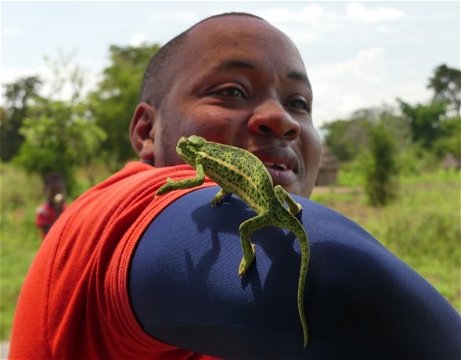

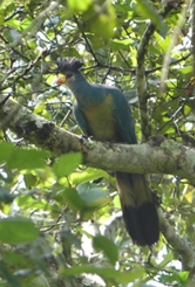
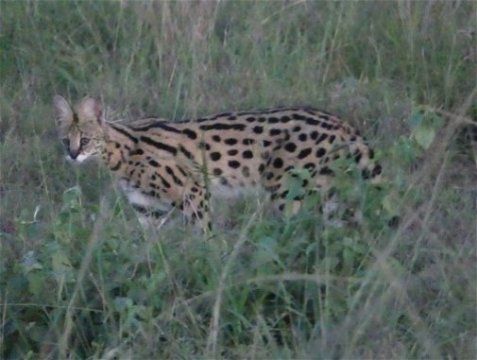


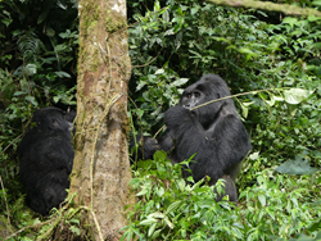
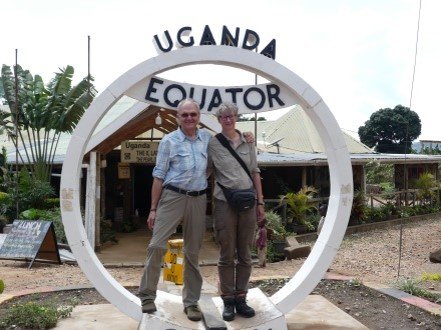
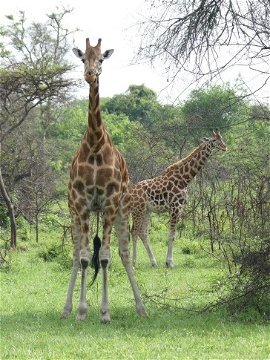
Share This Page